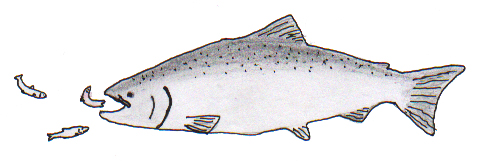 This collection of student work is from Frank Keim's classes. He wants to share these works for others to use as an example of culturally-based curriculum and documentation. These documents have been OCR-scanned and are available for educational use only.
This collection of student work is from Frank Keim's classes. He wants to share these works for others to use as an example of culturally-based curriculum and documentation. These documents have been OCR-scanned and are available for educational use only.Special | A | B | C | D | E | F | G | H | I | J | K | L | M | N | O
P | Q | R | S | T | U | V | W | X | Y | Z | ALL
Coho or Silver Salmon: Coho or Silver Salmon
(Oncorhynchus kisutch) (Qaki iyaq) Coho salmon, also called Silver salmon in central and western Alaska, are found in coastal waters of Alaska from Dixon Entrance in Southeastern, as far north as Point Hope, then up the Yukon River to the Alaska-Yukon border. Coho's are characterized by their aggressive behavior and their adaptability. They are tied with Chums as the second largest species of salmon, weighing up to twenty-one pounds with a length of over three feet. An average full-sized male will usually be about ten pounds and 29 inches long. The spots and gums are not as darkly pigmented as the King salmon. When they spawn, both sexes turn a dark reddish-maroon color, and the male develops an extremely hooked snout with large snaggly teeth. Coho salmon enter spawning river systems from August through November, usually during periods of high water. The adults school in pools, ponds or lakes for several weeks until they are ready to spawn. Spawning occurs mostly during the night. Several spawning acts occur until the female has deposited between 2,400 to 4,500 eggs. Coho's are caught commercially and by sport fishermen. Both groups catch about two million fish per year. The Coho salmon is the major marine sport fish in the state and is available in coastal waters from July through September. They are also a popular stream fish. They are mostly accessible to anglers from August to October. At that time they are caught with salmon egg clusters, spoons, spinners and streamer flies. The value of commercially caught Coho salmon in Alaska is next to that of Sockeye Salmon. By Jonathan Boots
| |
|




